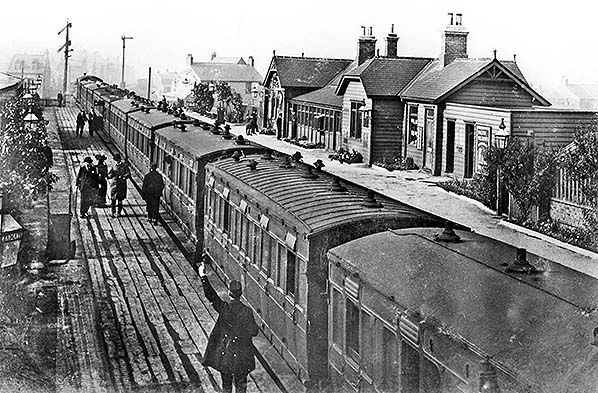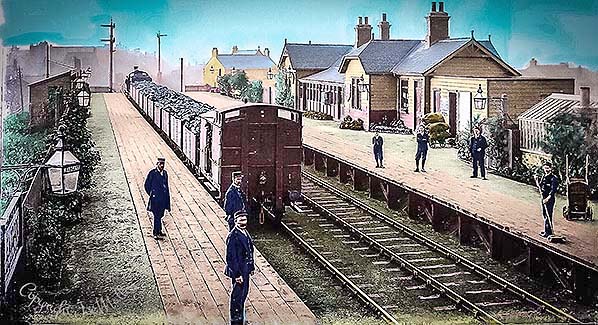
Station Name: LEADGATE[Source:
Nick Catford]
 Station staff pose for the camera at Leadgate station before 1906 as a Consett train approaches the down platform. The platforms of timber construction. The main building on the up platform was of timber construction with brick chimneys and a pitched slate roof with a glass-fronted verandah facing the platform. The building was similar to that at many other country stations provided by the NER at
this time. Copyright photo from John Alsop collection  
1896 1:2,500 OS map shows the the site of the future Leadgate station. The land has been fenced prior to the station being built.

1921 1:2,500 OS map shows the layout of the station as built.

1947 1:2,500 OS map. Little has changed other than the removal of the short siding and the two buildings at the back of the yard. A new building has appeared on the south side of the two
remaining sidings  Leadgate station looking east along the up platform c1907. The down platform was provided with a typical NER style timber waiting shelter with a sloping roof. Eden Colliery is seen in the distance. Eden Colliery was located just west of South Medomsley Junction. The colliery was closed under the auspices of the National Coal Board in July 1980.
Copyright photo from John Alsop collection  The guard is anxious to restart his Consett-bound train at Leadgate as a member of staff approaches to close an open carriage door, sometime in the early years of the 20th century. The largely wooden station, perched on an embankment, has copious greenery and is well provided with lamps. On a dark evening, the station must have had a very pleasant atmosphere providing, that is, a gale wasn't blowing. The train is formed of no less than ten vehicles, mostly five-compartment types and probably four-wheelers. Partly out of the picture, bottom right, is a brake third and one of its tail lamps is just visible at the bottom of the picture. On the centre compartment door of the second vehicle from the camera the North Eastern Railway crest can be seen. In the absence of a precise date, the livery of the train is a matter of debate but it was most likely crimson lake with yellow lining and beading while the locomotive would have been in the well known NER light green with black-lined-white boiler bands and red/brown frames. In the background stands the Commercial Hotel. This establishment survived into the 21st century but closed, it is believed, sometime around 2012.
Photo from John Mann collection 
An eastbound coal train waits in the down platform at Leadgate some time in NER days as staff pose for the camera.
Photo by Billy Costello, colourised by his great grandson Joe Mallon  Staff pose on the up platform at Leadgate station looking east c1910. Leadgate was clearly a well kept station with many plants decorating the platform. The goods yard is behind the up platform.
Copyright photo from John Alsop collection old8.jpg) Another view of the very well kept up platform at Leadgate station c1915. This photo was received from Elizabeth Hogg, then in her late 70s / early 80s in 1978. During WW1 she worked at the station as her contribution to the 'war effort' when the menfolk had gone to fight, and she said the photo was taken at that time. Perhaps she is the lady standing on the platform.
Photo from Alan Young collection  The upper quadrant signals, left, tell us this photograph dates from sometime after 1920 as the original lower quadrant signals were still in situ during that year. The background of the photograph has suffered some sort of whiteout, obliterating all but one end wall of the signal box in the process, yet all the bushes remain visible. The suggestion, therefore, is that part of the signal box had been deliberately obliterated to make the locomotive stand out more clearly. This practice was more familiar with official photographs of locomotives and rolling stock, where virtually everything in the background was obliterated. Whilst the coal train may at first glance appear to be nothing remarkable, it is in fact a train of the Consett Iron Company which had running rights over NER tracks between, in this instance, Eden Colliery and Consett. Such trains were once a familiar sight, especially in the North East, and the practice continued well into British Railways days. The locomotive is a long boilered 0-6-0 Pannier Tank, designed and built by Robert Stephenson & Co. and introduced in the 1880s. The plate on the cabside is the worksplate, the stock number being on the sides of the tanks but not visible in this view. The type was long lived, for example 'A. No.5' lasted until 1968 and has survived into preservation. At the time of writing she was at the Stephenson Railway Museum, North Shields.
Photo from Jim Lake collection  Leadgate signal box on a cold winter day.

Ex-LNER Gresley class V1 2-5-02 Tank No 67658 heads west towards Consett in 1955. This loco was built at Doncaster as LNER No 461 in April 1936. She was rebuilt as a V3 with s 200psi boiler in January 1960 but three years later she was withdrawn from Gateshead shed on 30 June 1963 and cut up at Darlington Works in February 1964. The station gardens are still tended but not the but not as well as in 1920.
Copyright photo by Jim Sedgwick 
Looking east at the site of Leadgate station in June 2011. St Ives Gardens now occupies the site
of the station. Photo by Nick Catford
 Home Page Home Page
|
 A signal box stood at the east end of the Consett platform. This controlled access to the goods yard which comprised three sidings trailing in from the up line; two sidings ran behind the up platform and a third shorter siding (later removed) ran up to the platform.
A signal box stood at the east end of the Consett platform. This controlled access to the goods yard which comprised three sidings trailing in from the up line; two sidings ran behind the up platform and a third shorter siding (later removed) ran up to the platform. The station closed to passengers on 22 May 1955 but the goods service survived until 10 August 1964. Good traffic at Leadgate in 1899 (excluding major minerals such as coal, coke, lime and limestone) consisted of 1,445 tons sent and 6,450 tons received.
The station closed to passengers on 22 May 1955 but the goods service survived until 10 August 1964. Good traffic at Leadgate in 1899 (excluding major minerals such as coal, coke, lime and limestone) consisted of 1,445 tons sent and 6,450 tons received.